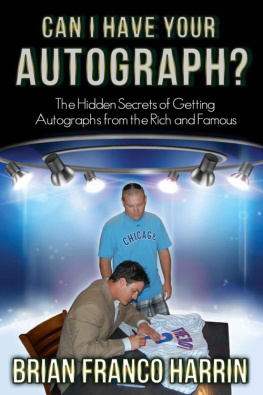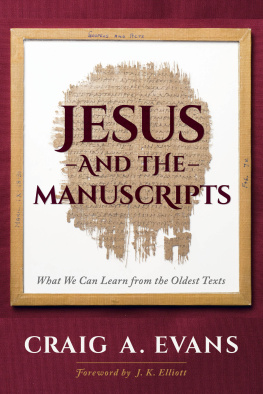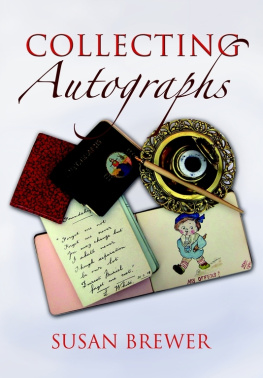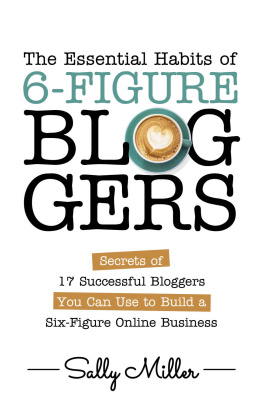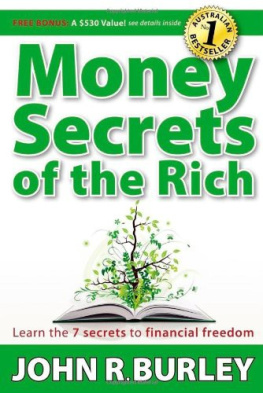All rights reserved. No part of this publication may be reproduced or transmitted in any form or by any means electronic or mechanical including photocopy, recording, or any information storage and retrieval system now known or to be invented, without permission in writing from the publisher, except by a reviewer who wishes to quote brief passages in connection with a review written for inclusion in a magazine, newspaper, or broadcast.
This book is dedicated to all the autograph collectors who take pride in preserving and cherishing the snapshots of history captured in the form of autographs.
I also want to thank my family for supporting me and all the great signers past and present.
Table of Contents
PREFACE
My intention in writing this book was to offer people a definitive resource on autograph collecting, to help them be aware of the various types of non-authentic signatures, and to inspire those who may not know much about the hobby to experience the sense of fulfillment many collectors enjoy with the ownership of signatures from all sorts of genres.
INTRODUCTION
If you think that autographs are just for kids, then youre in for a real shock. Over three million people now collect autographs in this business that generates more than $4 billion a year. If you somehow find an original William Shakespeare autograph at your local garage sale, you are now worth nearly $3 million!
Autographs are a snapshot of history captured in time, but many folks today wonder whether or not they have a truly authentic autograph, where they should purchase autographs, what are their autographs worth, and how do they get into the hobby?
If you are asking yourself any of these questions, I strongly urge you to turn the page and put your mind at ease with the wealth of insight presented in this book. I have been enjoying the hobby of autograph collecting since I got my first autograph from San Antonio NBA player Antonio Daniels at a basketball camp I participated in when I was a young kid. That moment sparked a lifelong interest in the hobby, and now I am going to share different areas of knowledge on the subject of collectingfrom purchasing real autographs, to figuring out how to detect fake signatures, as well as how to collect autographs through the mail.
After you turn that first page, you will be well informed on all things associated with autograph collecting, and you will not be the unfortunate one who gets ripped off on fake autographs.
I stopped believing in Santa Claus when I was six. Mother took me to see him in a department store and he asked for my autograph. Shirley Temple

Figure 1: Shirley Temple from the 1933 short film Glad Rags to Riches (Public Domain)
CHAPTER 1: THE BEGINNINGS OF AUTOGRAPH COLLECTING
As an autograph collector myself, I was always curious about how it all started. How did this whole hobby come about and what were the origins of its creation?
The earliest account of a form of autograph collecting begins in the 16th century with German students. The traveling scholars kept books containing letters of correspondence written by people that they had encountered during their Wanderjahren or journeys.
Their album collections served as a sort of filing system for letters of introduction for the student at future destinations along his travel or route. The value of these autographs was their ability to open doors for the students, rather than the value of the actual handwriting of the signers as weve come to known the hobby currently.
A form of autograph collecting that we could associate with today started in the later 18th century when people of leisure started to assemble collections of correspondence and various literary manuscripts written by the famed men of politics and letters. The main objective at the time was to collect monumental figures from the past, such as the famed poet John Milton.
As the 19th century rolled along, people began to expand their collections to living authors and statesman, whom they had admired. These early autograph collectors had some main justifications regarding collecting, one being for historical purposesto preserve the documents or correspondence of an important figureand the other being to showcase the collectors social prominence because although there wasnt a marketplace established for autographs, to have access to them meant you were a respected figure in the various social circles.
Now focusing on America, autograph collecting did not begin here at home until about 1815. Early accounts from the 19th century hail William Sprague of Albany and Israel Tefft of Savannah as the first big autograph collectors although they soon would be followed by many others.
These early American collectors were in a different position in relation to their European counterparts because of an unavailability of distinctive American literature, leaving the hungry autograph collectors to focus on the writings of respected national and local statesman. It was not until the influx of national literary figures such as Washington Irving and their contemporaries that autograph collecting in America shifted into full force.
An increased demand helped fuel the development and creation of a commercial marketplace for autographs. With the first generation of American autograph collectors silently disappearing, their collections began winding their way to the public via auctions, which were first held in England in the 1830s and later in America.
In 1850, the famous literary figure James Fenimore Cooper wrote a letter to autograph collector Mrs. Hamilton Fish saying that he would have no trouble sending her a dozen autographs as he received and complied with such requests from perfect strangers almost daily. I guess Mr. Cooper got just a little bit of fan mail!
Political figures begin receiving autograph requests in the mail, and some folks even had the courage to ask for locks of hair! Dont try that today! During the 1848 presidential campaign, Zachary Taylor was receiving many such requests, something that his cousin James Madison would have never seen in his 1812 campaign. In 1860, Abraham Lincoln had so much fan mail coming in that he set secretaries to fulfill the requests for his signaturehence the beginnings of the dreaded secretarial signature.

Figure 2: James Fenimore Cooper, Circa 1850 (Public Domain)
New York City was booming in the 1880s, and a great sense of pride and excitement sparked around the city. A lot of new and old money was being spent on personal collecting. Establishments such as the American Art Association auction house sprung up like wildflowers as the collecting bubble expanded.

